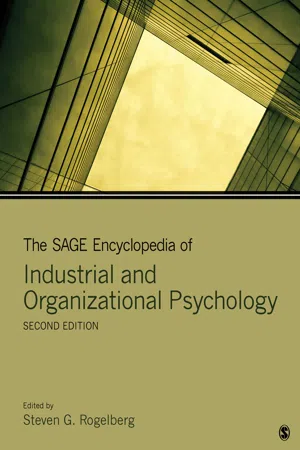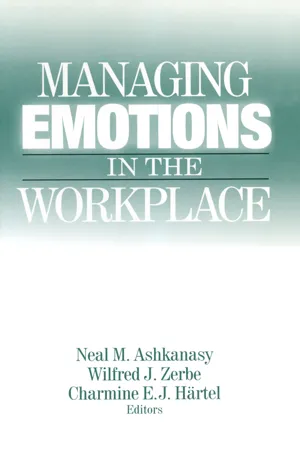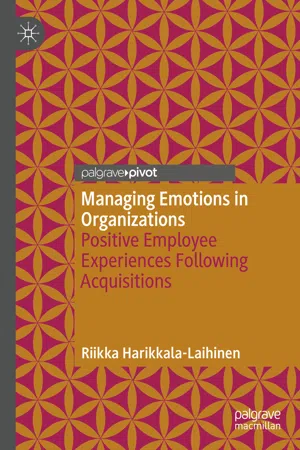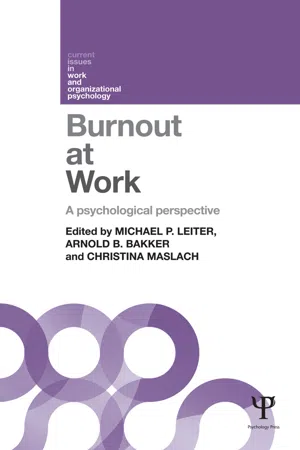Business
Affective Events Theory
Affective Events Theory (AET) proposes that events in the workplace can trigger emotional reactions in employees, which in turn influence their attitudes and behaviors. These emotional reactions can impact job satisfaction, motivation, and performance. AET emphasizes the importance of understanding and managing employees' emotions to create a positive work environment and enhance organizational outcomes.
Written by Perlego with AI-assistance
5 Key excerpts on "Affective Events Theory"
Learn about this page
Index pages curate the most relevant extracts from our library of academic textbooks. They’ve been created using an in-house natural language model (NLM), each adding context and meaning to key research topics.
- Steven G. Rogelberg(Author)
- 2016(Publication Date)
- SAGE Publications, Inc(Publisher)
Affective Events Theory Affective Events TheoryBrian Francis Redmond Brian Francis Redmond Redmond, Brian Francis25 27Affective Events Theory
Brian Francis RedmondAffective Events Theory (AET) is a theory of affect (the broader term for emotional experiences, including emotion and mood) in the workplace. In addition to focusing on affect, AET encompasses cognitions, behavior, attitudes, and other crucial psychological constructs to explain job behavior and performance. The theory builds primarily on the already established cognitive appraisal models and has gathered support from many areas of study in the field of emotions to create a more encompassing theory of work behavior.According to AET, there are two paths to job behaviors, both of which are influenced at least partially by affective reactions to events at work. However, cognitive processes play an essential role in the creation of these reactions. The theory builds on past theoretical successes while adding a few new elements in explaining job behavior. In particular, the notion of time is essential to the model, and it offers a more detailed explanation of emotion in the workplace.Assumptions of AET
Affective Events Theory makes several assumptions about the workplace and the constructs that describe people’s reactions to events that happen there. The first is that job satisfaction is different from affect. Nevertheless, AET also assumes that affect contributes to job satisfaction and can be used to help predict job performance. Related to that, AET assumes that affect influences performance, typically in a detrimental way because emotion is assumed to draw resources from other areas, such as cognitive processing, motivation, and attention, among others. Another major assumption in the AET framework is that events happen over time, which changes affect continuously. Those events influence a person’s immediate affective state but also vary over time as new events arise. Some events are likely to create positive reactions, others negative, and the degree of intensity will vary from event to event. Because affect is changing continuously within an individual, its influence on behavior is also changing continuously.- eBook - ePub
- Neal M. Ashkanasy, Wilfred J. Zerbe, Charmine E. J. Hartel(Authors)
- 2016(Publication Date)
- Routledge(Publisher)
Indeed, until Weiss and Cropanzano published their seminal paper on this topic in 1996, there was little in the organizational science literature that enabled scholars to appreciate properly the role of emotions. In AET, Weiss and Cropanzano argue that aspects of the work environment, including environmental conditions, roles, and job design, initiate emotions in organizational settings. These aspects of work thus constitute the “affective events,” described colloquially as “hassles and uplifts” (Basch and Fisher 2000), that act systematically to determine affective states. These states, in turn, lead to attitudinal and behavioral outcomes. Emotions can also directly lead to behavioral outcomes such as productive work (see Wright, Bonett, and Sweeney 1993; Wright and Cropanzano 1998), pro- or antisocial actions (Organ 1990), or turnover behavior. AET also incorporates trait affectivity, a personal disposition that conditions the formation of positive and negative emotions. AET is illustrated in Figure 1.1. Figure 1.1 Affective Events Theory From the perspective of the current volume, which deals with managing emotions in workplace settings, AET is of critical significance. It tells us that organizational characteristics and managerial policies can affect the emotional states of organizational members, and that these, in turn, can affect members’ attitudes and performance. Although Weiss and Cropanzano (1996) initially presented their model as an untested theory, and research is still in early stages, results to date have been strongly supportive of the core ideas in the theory. Examples of studies to date include Fisher (2000); O'Shea, Ashkanasy, Gallois, and Härtel (1999; 2000a, b); Fisher and Noble (2000); and Weiss, Nicholas, and Daus (1999). These studies have all supported the idea that emotional states mediate the effect of work events on outcomes - eBook - ePub
Managing Emotions in Organizations
Positive Employee Experiences Following Acquisitions
- Riikka Harikkala-Laihinen(Author)
- 2020(Publication Date)
- Palgrave Macmillan(Publisher)
2015 ).What makes the event affective is that it stimulates a reaction based on a job-related agent, object, or occurrence. This reaction includes appraisal and an emotional reaction, and can reflect either a transitory or ongoing work-related goal (Basch and Fisher 1998 ). The affective events can be categorized as being in the task-related or interpersonal spheres. Task-related events influence the execution of job assignments, whereas interpersonal events concern colleagues (Casper et al. 2019 ). In addition to the triggering event itself, the work environment may influence the resulting emotional reaction. For example, should the atmosphere at work be stressful, a superior’s critique is likely to cause anger, which leads to job dissatisfaction and possibly even an open argument or leaving the company (Mignonac and Herrbach 2004 ). Nevertheless, individuals differ in their personal disposition towards emotions, often highlighting either positive or negative experiences, thus also influencing which emotions are likely to emerge at work (Fisher 2002 ).3.3 Emotions Following Acquisitions
Focusing on the human side of acquisitions reveals them to be a process of adaptation (Cartwright and Cooper 1995 ). This process is often named acculturation ; the making of a unified culture from previously separate beliefs, assumptions and values (Larsson and Lubatkin 2001 ). Acculturation includes the coming together, clashing and adaptation necessary to achieve a harmonious coexistence (Nahavandi and Malekzadeh 1988 ; Rottig et al. 2013 ). The resultant conflict and adaptation often lead to change resistance, at worst giving rise to the merger syndrome —a fear-the-worst response increasing stress and anxiety (Marks and Mirvis 1997 ; Kusstatscher and Cooper 2005 ; Sinkovics et al. 2011 - eBook - ePub
Effective Leadership
Theory, Cases, and Applications
- Ronald H. Humphrey(Author)
- 2013(Publication Date)
- SAGE Publications, Inc(Publisher)
Affective Events Theory to explain how workplace events influence our moods and emotions. Have you ever been in a good mood at work, perhaps chatting with an attractive or amusing coworker, when you spill coffee on yourself? There goes your good mood, replaced by the emotion of embarrassment. Or perhaps you are feeling bored and unmotivated, and the boss stops by and congratulates you on your last project. Sudden mood perk! Or perhaps your emotions swing rapidly due to a mix of good tips (happiness) and pushy and demanding customers (anger, irritation). According to Affective Events Theory, these almost random events that are intermittently boosting or depressing our moods and emotions throughout the day have a big impact on our work attitudes and behaviors.According to the leaders as mood and emotion managers perspective (e.g., Humphrey, 2002; Pescosolido, 2002), one of the duties of a leader is to create positive affective events for subordinates and to help subordinates cope with the negative events that do occur. Leaders are also likely to be more resistant to the mood dampening effects of negative events (Humphrey, Pollack, & Hawver, 2008) because of their greater resiliency (Hannah & Luthans, 2008; Luthans & Avolio, 2003).A heavy workload or a series of frustrating events can easily drain our energy at work. When this happens, how can we restore our vitality? Fritz, Lam, and Spreitzer (2011) surveyed 214 knowledge workers who worked for a U.S. software development company. Here is what they found: - eBook - ePub
Burnout at Work
A psychological perspective
- Michael P. Leiter, Arnold B. Bakker, Christina Maslach, Michael P Leiter, Arnold B Bakker, Christina Maslach(Authors)
- 2014(Publication Date)
- Psychology Press(Publisher)
This example illustrates that experiences of exhaustion, cynicism, and professional efficacy may change substantially within the same employee from one moment or day to another as a response to the continuously changing job characteristics and work-related events. Since there is evidence suggesting that work conditions (i.e., levels of job demands and job resources) vary substantially from one workday to another (Butler et al., 2005; Xanthopoulou et al., 2009; Xanthopoulou et al., 2008), it may be argued that reactions to these conditions may vary accordingly. This micro-approach in the study of burnout is supported by Weiss and Cropanzano’s (1996) AET, which proposes that specific critical events at work are the most proximal causes of employees’ affective reactions to these events. For example, the occurrence of pleasant events (e.g., having a nice conversation with a client) may elicit momentary positive emotions (e.g., happiness, satisfaction), while unpleasant events (e.g., arguing with a colleague) may elicit momentary negative emotions (e.g., frustration).Building on AET, Beal and Weiss (2013) provided a more elaborate analysis of how critical events at work explain emotional and, consequently, behavioral reactions on a daily basis. These authors proposed that life at work can be partitioned in a series of episodes, and that employee experiences and behaviors may be best examined in relation to these episodes. They distinguished between emotion episodes that concern how people feel with respect to a specific event at work, and performance episodes that concern what people did with regard to a specific event or goal at work. Events are the initiators of both types of episodes and refer to “any aspect or occurrence of one’s environment that influences another element or stream of experience” (Beal & Weiss, 2013, p. 17). As such, the main characteristic of events is that they are clearly exogenous experiences that can have a potentially beneficial or harmful effect on employee momentary well-being. Beal and Weiss (2013) recognize that the extent to which an event will influence an employee is determined by its nature, with shock-like events being far more influential than routine ones.In this context, we argue that daily experiences of exhaustion, cynicism, and professional efficacy may be examined in relation to specific events or episodes because how employees feel depends on what is happening at work on a day-to-day basis and during different instances throughout a day (Beal & Weiss, 2013). As episodic experiences, these may vary substantially within the same employee from one moment or workday to another since they depend highly on the specific critical events that take place during each day at work. A first advantage of the episodic approach in the study of burnout is that surveying individual burnout experiences the moment that they occur facilitates capturing their dynamic nature (Xanthopoulou et al., 2012a). In other words, it is possible to investigate whether and how exhaustion, cynicism, and efficacy experiences change within the same person across short periods of time as a response to specific episodes or critical work events.




